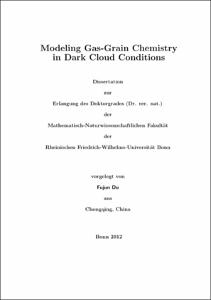Du, Fujun: Modeling Gas-Grain Chemistry in Dark Cloud Conditions. - Bonn, 2012. - Dissertation, Rheinische Friedrich-Wilhelms-Universität Bonn.
Online-Ausgabe in bonndoc: https://nbn-resolving.org/urn:nbn:de:hbz:5n-29496
Online-Ausgabe in bonndoc: https://nbn-resolving.org/urn:nbn:de:hbz:5n-29496
@phdthesis{handle:20.500.11811/5364,
urn: https://nbn-resolving.org/urn:nbn:de:hbz:5n-29496,
author = {{Fujun Du}},
title = {Modeling Gas-Grain Chemistry in Dark Cloud Conditions},
school = {Rheinische Friedrich-Wilhelms-Universität Bonn},
year = 2012,
month = aug,
note = {I first wrote a gas phase chemical code, which solves for the gas phase composition of an interstellar cloud as a function of time. We used this code to study the abundance ratios between the H3+ isotopologues, since in this case the interaction between processes in the gas phase and on the dust grain surface can be treated in a simplified way.
Grain chemistry is necessary to explain the formation of many interstellar molecules. My first investigation on grain chemistry is from the mathematical side, by looking deep into the difficulties posed by its stochasticity and discreteness. After writing a Monte Carlo code to serve as a benchmark, I developed a new method called ``hybrid moment equation'' (HME) approach, which gives results that are more accurate than those obtained with the usual rate equation approach, and it runs much faster than the Monte Carlo method for a medium-to-large-sized reaction network. Improvements in this HME approach are needed if a very large surface network is to be used.
Following the recent detection of hydrogen peroxide (H2O2) in the rho Ophiuchus~A cloud core, I modeled its formation with a gas-grain network. Its observed abundance, together with the abundances of other species detected in the same source can be reproduced in our model. These molecules are mainly driven into the gas phase from the dust grain surface by the heat released in chemical reactions. Our model predicted the presence of O2H molecule in the gas phase, which has indeed been detected recently. Further investigations are needed to answer whether H2O2 is widespread in the interstellar medium.
I then studied the chemistry involving species containing one or more deuterium atoms with a gas-grain-mantle three-phase model, which takes into account recent experimental results on the key reactions. The observed fractionated deuterium enhancement in water, methanol, and formaldehyde is reproduced in our models. I demonstrated that the existence of abstraction reactions for methanol and formaldehyde is the main reason for these species to be more prone to deuterium enhancement than water. The observed low [D2O/H2O] ratio suggests that water is mainly formed through H2 + OH → H2O + H on the dust grain surface. Our model also gives a range of ice mantle compositions for the dust grains that agree with the observations in different sources.},
url = {https://hdl.handle.net/20.500.11811/5364}
}
urn: https://nbn-resolving.org/urn:nbn:de:hbz:5n-29496,
author = {{Fujun Du}},
title = {Modeling Gas-Grain Chemistry in Dark Cloud Conditions},
school = {Rheinische Friedrich-Wilhelms-Universität Bonn},
year = 2012,
month = aug,
note = {I first wrote a gas phase chemical code, which solves for the gas phase composition of an interstellar cloud as a function of time. We used this code to study the abundance ratios between the H3+ isotopologues, since in this case the interaction between processes in the gas phase and on the dust grain surface can be treated in a simplified way.
Grain chemistry is necessary to explain the formation of many interstellar molecules. My first investigation on grain chemistry is from the mathematical side, by looking deep into the difficulties posed by its stochasticity and discreteness. After writing a Monte Carlo code to serve as a benchmark, I developed a new method called ``hybrid moment equation'' (HME) approach, which gives results that are more accurate than those obtained with the usual rate equation approach, and it runs much faster than the Monte Carlo method for a medium-to-large-sized reaction network. Improvements in this HME approach are needed if a very large surface network is to be used.
Following the recent detection of hydrogen peroxide (H2O2) in the rho Ophiuchus~A cloud core, I modeled its formation with a gas-grain network. Its observed abundance, together with the abundances of other species detected in the same source can be reproduced in our model. These molecules are mainly driven into the gas phase from the dust grain surface by the heat released in chemical reactions. Our model predicted the presence of O2H molecule in the gas phase, which has indeed been detected recently. Further investigations are needed to answer whether H2O2 is widespread in the interstellar medium.
I then studied the chemistry involving species containing one or more deuterium atoms with a gas-grain-mantle three-phase model, which takes into account recent experimental results on the key reactions. The observed fractionated deuterium enhancement in water, methanol, and formaldehyde is reproduced in our models. I demonstrated that the existence of abstraction reactions for methanol and formaldehyde is the main reason for these species to be more prone to deuterium enhancement than water. The observed low [D2O/H2O] ratio suggests that water is mainly formed through H2 + OH → H2O + H on the dust grain surface. Our model also gives a range of ice mantle compositions for the dust grains that agree with the observations in different sources.},
url = {https://hdl.handle.net/20.500.11811/5364}
}






